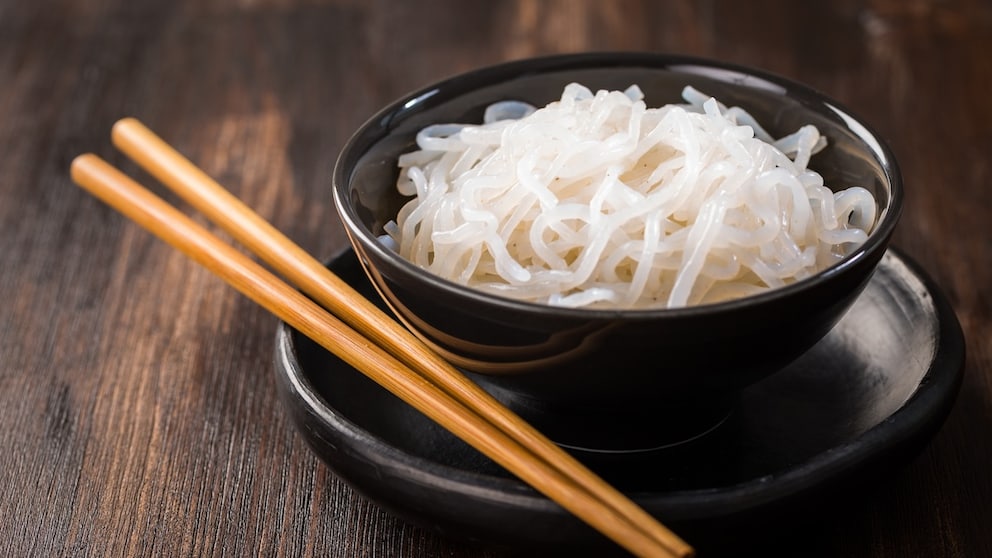January 15, 2025, 4:42 pm | Read time: 5 minutes
A new year means new resolutions! Losing weight is at the top of many people’s lists and goes hand in hand with cutting out carbohydrates. Pasta, in particular, is often removed from the menu. But that doesn’t have to be the case: an alternative to conventional pasta should make it possible to lose weight – even without giving up pasta. These are so-called “konjac noodles,” which contain hardly any calories.
The secret lies in the nutritional values themselves: konjac noodles have no carbohydrates and consist mainly of fiber-rich konjac flour and water. Find out below whether these noodles can really help you lose weight, what the disadvantages are, and what the consumer advice center says about them.
Overview
What are Konjac Noodles?
The most significant difference between konjac noodles and traditional noodles is in their production. Unlike cereals, they are made from the flour of a konjac root. The flour is obtained from the tubers of the root, which is also known as “devil’s tongue.”
The texture of the ‘devil’s tongue’ is somewhat similar to that of a potato. In addition, the root has no usable carbohydrates, starch, or protein. Its composition is exclusively water and fiber, the latter being the reason for the noodles’ unique characteristics.
Origin of the Low-Calorie Noodles
The konjac plant is widespread in East Asia and is a traditional vegetable that has been cultivated and eaten for centuries in Korea, China, Japan, and other Asian countries. However, the original invention of konjac noodles is attributed to Japan, as they were particularly popular with samurai and monks due to their quick and easy preparation.1
How Konjac Noodles Are Made
As already mentioned, konjac noodles are made from the flour of the peeled and cooked konjac root. The root is first ground, and then the flour is mixed with water to form a dough. The dough is then formed into the desired shape, and the noodles are cooked. After cooking, they are rinsed in cold water, dried, and packaged.
Types
There are several types of konjac noodles, which differ mainly in their shape, texture and size:
- Shirataki noodles: this well-known variety is often used as a synonym for konjac noodles. Shirataki noodles are long – you can imagine them to be about as thick as udon noodles.
- Ito konnyaku noodles: These have a more elastic structure and are thicker than shirataki noodles. Sometimes, they are also available in different shapes (cube or spiral).
- Juruo noodles: This type of noodle is characterized by its particularly thin shape and soft texture.
- Kishimen noodles: In appearance, these noodles tend to be wide and flat – and also slightly thicker than the shirataki noodles mentioned above.
How Healthy Are Konjac Noodles?
With around 90 percent water, konjac noodles are particularly low in carbohydrates and calories. Even though they contain few minerals and vitamins, they can be a good alternative to conventional noodles when combined with nutrient-rich foods. Per 100 grams, they contain around eight kilocalories, four grams of carbohydrates, two grams of protein, and three and a half grams of fiber.
Interestingly, the glucomannan fiber it contains can help with the absorption of minerals from other foods, which aids digestion. They are also gluten-free and suitable for people who suffer from intolerances.2
Can Konjac Noodles Really Help You Lose Weight?
Due to their low calorie content, konjac noodles are suitable for a diet aimed at weight loss. The glucomannan fiber in the noodles can absorb up to 50 times its own weight in water. As a result, the pasta alternative continues to swell in the stomach after consumption – which keeps you full for longer. However, it is not possible to achieve weight loss with just one food. This necessitates a comprehensive dietary overhaul..3
Storage and Shelf Life
Unopened konjac noodles can be kept for several months. It is best to store them in a dry, cool place away from sunlight. Because the noodles lack preservatives, they are vulnerable to bacterial contamination. If you open the packaging, you should use it as soon as possible.
Preparation
Preparing konjac noodles is also quick and easy. After removing the noodles from the packaging, rinse them thoroughly under running water. They can then be blanched in boiling water for about one to two minutes or fried directly in a pan (with a little oil).
Konjac noodles taste particularly good in Asian soups, stir-fries with vegetables, fish, and meat, or in salads. As they have a neutral taste, they can be served well with strong spices and sauces.4
What the Consumer Advice Center Says
According to the European Food Safety Authority (EFSA), there are two so-called “health claims” that have been approved for glucomannan:
- Glucomannan can support weight loss (as part of a low-calorie diet).
- Glucomannan may contribute to the maintenance of normal blood cholesterol levels.5
Given that konjac noodles are composed of water and fiber, they offer limited nutritional benefits due to their minimal nutrient content. It is also advisable to follow the preparation instructions and warnings.

Nutrition tips from an expert 5 healthy snack recipes that keep blood sugar levels down

Nutrition Expert Assesses Vegetable Red Cabbage is Very Healthy and Low in Calories

Ideal for strength athletes 3 Protein-Rich Air Fryer Snacks
Are There Any Side Effects?
As a rule, konjac noodles are well tolerated and do not trigger any allergic reactions. However, overconsumption may result in side effects, including abdominal pain, bloating, and a sensation of fullness.6
With material from dpa

